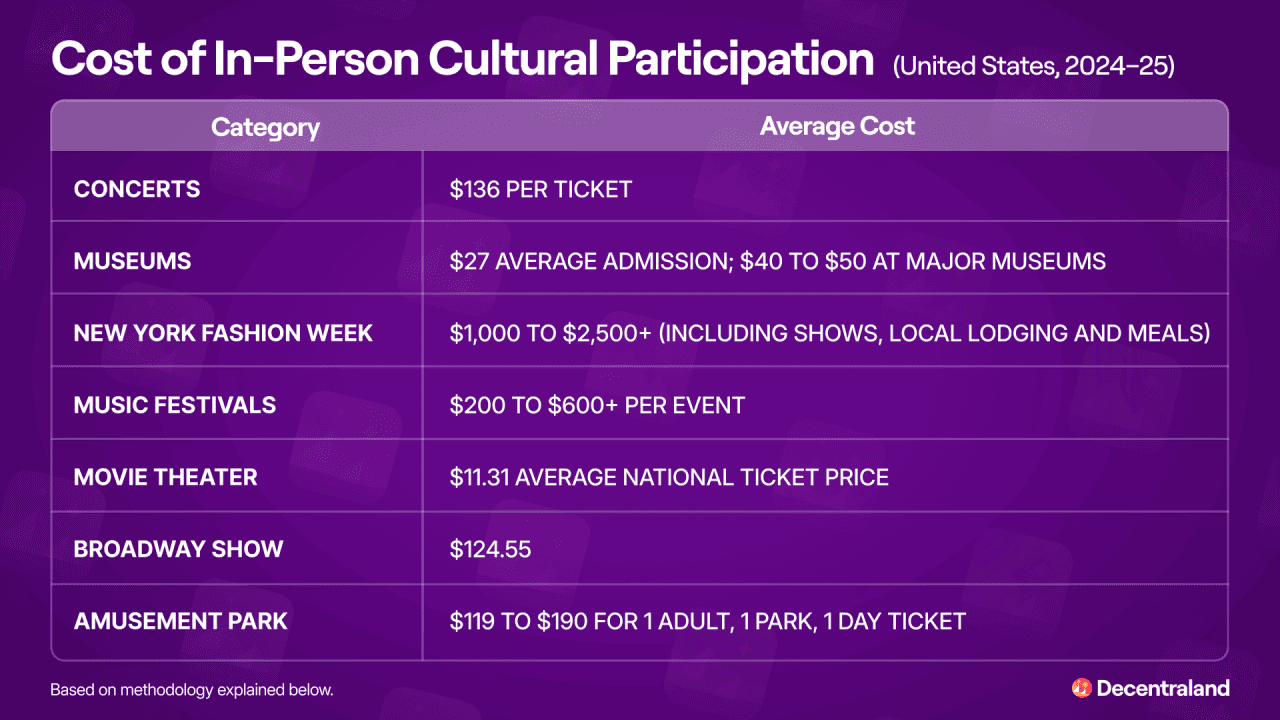
November 20, 2025
Somewhere between the service fees, dynamic pricing, and VIP experiences, prices of culture have crept up fast.
“Do people realize the amount we have to pay for concert tickets is not normal?” Last month, this seemingly innocuous tweet struck a nerve because it’s true—ticket prices today are not normal. Somewhere between the service fees, dynamic pricing, and VIP experiences, prices of culture have crept up fast. The average concert ticket in the U.S. now costs about $136, according to a report by industry trade magazine Pollstar, and museum tickets, which used to cost a few dollars, can now set you back $40 to $50, based on the American Alliance of Museums (AAM) and Wilkening Consulting’s 2024 Annual Survey of Museum-Goers.
The things that used to bring people together, like music, art, and shared experiences, are beginning to feel like gated spaces. That same survey found that cost is now the No. 1 reason why occasional museum-goers choose not to attend more often. Meanwhile, the 2024 Arts Funding Snapshot from Grantmakers in the Arts found that public arts funding in 2023 dropped to just $3.94 per person, a 43% decrease from 2022, when adjusted for inflation and population growth—a sign that cultural funding is struggling to keep pace with community demand. So it’s worth asking: Who can still afford to show up, and what can the rest of us do?
One answer, Pew Research Center has found, is to turn to the internet. Ninety-six percent of U.S. adults now use the internet, and 79% have broadband at home, according to a 2024 study by the think tank. Over 2,000 museums, galleries, and cultural institutions are now available to explore through Google Arts & Culture. The Association of Science and Technology Centers’ Museum Digital Engagement: Before, During, and Beyond the COVID-19 Pandemic report found that digital engagement continued long after pandemic restrictions were lifted, with many museums still investing in hybrid and virtual experiences due to visitor demand.
This migration to the web suggests that perhaps culture isn’t dying; it’s just moving to more accessible virtual spaces. Ahead, Decentraland Foundation examines the cost of cultural participation in 2025, drawing on data from Pollstar, the National Endowment for the Arts (NEA), the Bureau of Labor Statistics (BLS), and insights from virtual worlds.
The cost of showing up to cultural events
Cultural participation in 2025 requires cash—and pretty considerable sums of it. Pollstar’s 2024 year-end analysis put the average concert ticket for the top 100 touring artists in North America at $136.45, up 41% from $96.17 in 2019. That doesn’t include service fees, merchandise, and travel costs. While global grosses reached record highs in 2024, North America saw a decline in ticket sales and average attendance per show.
Museum costs have risen, too. The AAM reported in 2024 that U.S. adult admissions averaged $27, with many big institutions charging $40 to $50. Among those who visit museums “occasionally,” cost was named as the No. 1 reason they don’t go more often.
Fashion events are even further out of reach. A trip to New York Fashion Week, including travel, accommodation, and access to shows, can cost between $1,000 and $10,000, according to pricing compiled by FashionWeekOnline. And that’s if you can get in. Most shows remain invite-only.
These numbers are in huge contrast to household income. The BLS 2023 report shows that while average annual incomes have gone up since 2019, they have not kept pace with inflation-adjusted increases in entertainment spending. The BLS groups culture-related expenses under “entertainment,” a category that also includes everything from cable subscriptions to concert tickets (as defined in its glossary). Within it, “fees and admissions” covers the cost of attending: entry to concerts, theaters, sporting events, movies, and museums, as well as costs for clubs and other social venues. This is where the rising cost of culture is most evident.
Between 2019 and 2023, spending on “entertainment” increased by over 25%, while average annual household income rose by only 17%, and general inflation by roughly 20%. In other words, the price of going out has risen faster than wages and inflation.
Cost of In-Person Cultural Participation

Methodology: Figures are drawn from industry and federal data sources, including Pollstar (concert pricing, 2024), the American Alliance of Museums (admissions, 2024), FashionWeekOnline (NYFW cost ranges, 2024), U.S. News & World Report (music festival pricing, 2025), The Numbers (national movie ticket prices, 2024), Broadway News (Broadway pricing, 2025), and WDW Magazine (theme park ticketing, 2025). All costs are expressed in USD. Ranges reflect averages across major U.S. institutions and events.
Geography still matters
Cultural access in the U.S. also depends on where you live. The internet may have globalized creative content, but in-person culture—including galleries, theaters, concerts, and festivals—is still concentrated in cities and wealthy areas. For millions of Americans in rural or low-income neighborhoods, taking part means crossing both literal and financial distances.
The NEA’s Arts in Neighborhood Choice report found that people who prioritize access to culture tend to pay more to live near it. Thirty-five percent of householders who said that living conveniently to arts and cultural events was “very” important also reported housing costs of $1,500 or more per month, compared to just 23% of people who said culture access was “not important.” In other words, cultural proximity comes at a premium and is something people with higher incomes can afford to choose.
Distance matters, too. A 2021 report from University College London examined who engages in the arts in the U.S. and found that people in rural areas are significantly less likely to attend live events or visit museums, largely because of lower income levels and a lack of nearby options. While the research does not directly itemize costs like travel, parking, or work time loss, the reduced attendance among less urban residents points to access barriers tied to geography and socioeconomic status.
Increasingly, however, virtual experiences are stepping in where physical access falls short. Social virtual worlds where people can attend concerts, exhibitions, and events together in 3D spaces are beginning to fill some of that gap.
As early as 2012, researchers at Roskilde University described virtual worlds as “environments that carry the potential for social and cultural innovation,” enabling people to form new kinds of relationships and shared experiences. A decade later, that vision is materializing. Virtual spaces offer something traditional culture can’t: convenience, flexibility, and access. For those distanced by location, income, or caregiving, logging on may be the only way to show up.
The behavioral shift
While in-person attendance has declined, digital and hybrid participation is growing fast. The NEA’s Online Audiences for Arts Programming report found that 82% of U.S. adults participated in some form of digital arts activity between 2021 and 2022, including livestreamed concerts, online museum tours, podcasts, and virtual classes. About 30% said they were doing these more often than the year before, showing that digital participation is now a habit, not a pandemic stopgap.
The same pattern shows up in film and entertainment. An Associated Press poll found that 3 in 5 Americans now prefer streaming at home to going to the cinema, citing cost and convenience as the main reasons. Box Office Mojo data shows that 2024 ticket sales remain around 20% below pre-pandemic levels despite record studio output, while streaming platforms continue to expand. Netflix added a record number of subscribers last year, according to the Financial Times.
Increasingly, rituals that once defined a night out—wristbands, ticket stubs, Sharpie Xs on our hands—are being replaced by the frictionless habit of logging in. And that login leads not just to films, but to concerts, theatre broadcasts, museum tours, and virtual worlds. Fortnite’s Remix: The Finale drew 14 million live viewers, according to IQ Magazine, showing that audiences aren’t disappearing but are showing up elsewhere.
Cost of Virtual Cultural Participation

Notes: Figures reflect typical consumer-facing costs for publicly accessible virtual cultural experiences in the United States. “Free” indicates there is no ticketing or admission charge, though activities require internet access and a compatible device. Price ranges represent common platform pricing for livestreams, workshops, and streaming services. Streaming prices reflect a four-subscriber home based on data from Deloitte’s 2025 digital media trends report. Virtual concert and workshop prices are based on Eventbrite data on average online ticket prices.
Methodology: Costs are based on publicly listed pricing from major streaming platforms, virtual event providers, and online learning sites between 2021 and 2025. All numbers are rounded for clarity.
Is digital culture really free?
Virtual doesn’t mean barrier-free. Online access still depends on basics: equipment, internet quality, and time. The USTelecom 2024 Broadband Pricing Index puts the average U.S. household internet bill at $72.58 per month, which is roughly $870 per year. Even when a virtual concert or exhibition is free, participation still requires an ongoing subscription just to connect.
Device access is another divide. The Benton Institute for Broadband & Society reports that 1 in 7 U.S. households lacks a computer or relies only on a smartphone, which is about 18 million homes, or 33 million people. While smartphones allow connection, they can’t replace large screens for creative work, video events, or education. Researchers call this “restricted digital participation.”
Baseline Digital Access Requirements (United States, 2025)

Notes: Digital participation assumes access to broadband internet and a desktop or laptop computer capable of streaming video and accessing interactive platforms. The $300 annual figure reflects a portion of the average U.S. broadband bill of $873, used for cultural activities such as streaming concerts, museum tours, and online classes. Device costs represent a standard laptop or desktop.
Methodology: Internet costs based on national broadband pricing data (USTelecom, 2024) and federal spending surveys. Internet and device access figures from the Pew Research Center and the Benton Institute for Broadband & Society. All figures rounded for clarity.
Culture in virtual worlds
As the cost of physical attendance climbs, virtual worlds are becoming a third space in the cultural economy, sitting alongside Netflix and YouTube but built around participation rather than passive viewing.
Decentraland hosts community-led events year-round—from art exhibitions and live performances to workshops, drawing people from over 100 countries to events where attendance is typically open and free. This user-driven structure highlights how virtual environments can expand access to cultural participation without relying on traditional gatekeeping or ticketing models. Other virtual environments depict similar cultural events.
For instance, the Epic Games-owned platform Fortnite has hosted free concerts with artists like Ariana Grande and Travis Scott, monetized through optional digital merch. And Roblox, the game creation platform developed by Roblox Corporation, has run branded performances by Lil Nas X and Twenty One Pilots. The virtual reality (VR) entertainment company WaveXR offers paid interactive shows with artists like Justin Bieber and The Weeknd, while Meta’s Horizon Worlds runs comedy clubs and festivals within its VR ecosystem (however, it’s important to remember that only 13% of U.S. households own a headset, reported G2).
As recent research into loneliness and online interaction shows, shared digital experiences can reproduce many of the social functions of live events, especially for those excluded by cost, distance, or accessibility.
This story was produced by Decentraland and reviewed and distributed by Stacker.
RELATED CONTENT: Bay Area Rapper LaRussell Makes Millions Letting Fans Name Their Price

